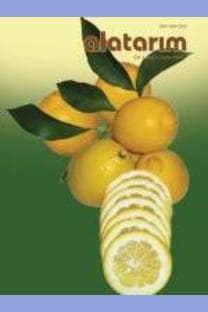Transgenik tütün bitkisi (pcV-ChMTIIGFP) ile bazı ağır metal uygulamalarının kök bölgesi toprakta mikrobiyal aktiviteye etkisi
Effect of transgenic tobacco plants (pcV-ChMTIIGFP) and different heavy metals applications on root zone soil microbial activity
___
- Bek, Y., 1983. Araştırma ve Deneme Metodları. Ç.Ü. Ziraat Fakültesi. Ders Notu. Yayın No: 92. Adana.
- Birch, A.N.E., Griffithsa, B.S., Caula, S., Thompsona, H., Heckmannb, L. H., Kroghb, P.H., Cortetd, J., 2007. The role of laboratory, glasshouse and field scale experiments in understanding the interactions between genetically modified crops and soil ecosystems: A review of the ECOGEN project. Pedobiologia (51): 251260.
- Bouyoucos, G.J., 1952. A recalibration of hydrometer for making mechanical analysis of soils. Journal of Agronomy (43): 434-438.
- Bruinsma, M., Kowalchuk, G.A., Veen, J.A.V., 2003. Effects of genetically modified plants on microbial communities and processes in soil. Biological Fertilization of Soils 37:329 337.
- Garcia, A.G., Altieri, M.A., 2005. Transgenic Crops: Implications for Biodiversity and Sustainable Agriculture. Bulletin of Science, Technology & Society 25 (4): 335-353
- Griffiths, B.S, Caul, S., Thompson, J, Birch, A.N.E., Scrimgeour, C., Cortet, J., Foggo, A., Hackett, C.A., Krogh, P.H., 2006. Soil microbial and faunal community responses to Bt maize and insecticide in two soils. Journal of Environmental Quality 35:734741.
- Icoz, I Stotzky, G., 2008. Fate and effects of insect-resistant Bt crops in soil ecosystems. Journal of Soil Biology & Biochemistry 40: 559586.
- Isermeyer, H., 1952. Eine einfache Methode zur Bestimmung der Bodenatmung und der Karbonate im Böden. Z. Pflanzenaehr. Bodenkd 5: 56-60.
- Lewandowski, J., Leitschuh, S., Koß, V., 1997. Schadstoffe im Boden. Heidelberg: Springer- Verlag.
- Loeppert, R.H., Suarez, D.L., 1996. Carbonate and gypsum. In Methods of soil analysis. Part 3. Chemical Methods, pp. 437-474. Edited by D.L. Spark. Madison, Wisconsin, USA.
- Nelson, D.W., Sommers, L.E., 1996. Total Carbon, Organic Carbon, and Organic Matter. In Methods of Soil Analysis. Part 3. Chemical Methods, pp. 961-1010. Edited by D.L. Spark. Madison, Wisconsin, USA.
- Öhlinger, R., 1993. Bestimmung des Biomasse-Kohlenstoffs mittels Fumigation-Extraktion. In: Schinner, F., Öhlinger, R., Kandeler, E., Margesin, R. (eds.). Bodenbiologische Arbeitsmethoden 2. Auflage, Springer Verlag, Berlin Heidelberg.
- Thalman, A., 1967. Über die mikrobielle Aktivitaet und ihre Beziehungen zur Fruchtbarkeitsmerkmalen einiger Ackerböden unter besonderer Berücksichtigung der Dehydrogenase aktivitaet (TTC-Reduktion) Diss. Giessen (FRG).
- Wei, X.D., Zou, H.L., Chu, L.M., Liao, B., Ye, C.M., Lan, C.Y., 2006. Field released transgenic papaya affects microbial communities and enzyme activities in soil. Journal of Plant Soil 285: 347358.
- ISSN: 1304-2653
- Yayın Aralığı: 2
- Başlangıç: 2015
- Yayıncı: Alata Bahçe Kültürleri Araştırma Enstitüsü
Şenay KARABIYIK, Fatma Seren SAĞIR, SİNAN ETİ, Bilge YILMAZ
Hatay ve Adana illerinde kavun üretiminin yetiştiricilik açısından değerlendirilmesi
Tohum gücünün değerlendirilmesi
Bazı organik ve kimyasal gübre uygulamalarının domateste verim ve kalite üzerine etkileri
E. Işıl DEMİRTAŞ, Cevdet Fehmi ÖZKAN, Filiz ASRİ ÖKTÜREN, Asri Nuri ARI
